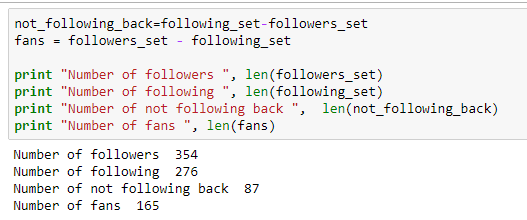@Rays
2017-08-28T12:20:29.000000Z
字数 6509
阅读 3048
使用Python对Instagram做数据分析
语言开发 Python
正文:
本文最初发布于KDnuggets网站,原作者Nour Galaby。本文经授权由InfoQ中文站翻译并分享。
我写此文的目的在于展示以编程的方式使用Instagram的基本方法。我的方法可用于数据分析、计算机视觉以及任何你所能想到的酷炫项目中。
Instagram是最大的图片分享社交媒体平台,每月活跃用户约五亿,每日有九千五百万的图片和视频被上传到Instagram。其数据规模巨大,具有很大的潜能。本文将给出如何将Instagram作为数据源而非一个平台,并介绍在项目中使用本文所给出的开发方法。
API和工具简介
Instagram提供了官方API,但是这些API有些过时,并且当前所提供的功能也非常有限。因此在本文中,我使用了LevPasha提供的非Instagram官方API。该API支持所有关键特性,例如点赞、加粉、上传图片和视频等。它使用Python编写,本文中我只关注数据端的操作。
我推荐使用Jupyter Notebook和IPython。使用官方Python虽然没有问题,但是它不提供图片显示等特性。
安装
你可以使用pip安装该软件库,命令如下:
python -m pip install -e git+https://github.com/LevPasha/Instagram-API-python.git#egg=InstagramAPI
如果系统中尚未安装ffmpeg,那么在Linux上,可以使用如下命令安装:
sudo apt-get install ffmpeg
对于Windows系统,需在Python解释器中运行如下命令:
import imageioimageio.plugins.ffmpeg.download()
下面使用API,实现登入Instragram:
from InstagramAPI import InstagramAPIusername="YOURUSERNAME"InstagramAPI = InstagramAPI(username, "YOURPASSWORD")InstagramAPI.login()
如果登录成功,那么你会收到“登陆成功”的消息。
基本请求
做好上面的准备工作后,我们可以着手实现首次请求:
InstagramAPI.getProfileData()result = InstagramAPI.LastJson
{u'status': u'ok',u'user': {u'biography': u'',u'birthday': None,u'country_code': 20,u'email': aaa@hotmail.com',u'external_url': u'',u'full_name': u'Nour Galaby',u'gender': 1,u'has_anonymous_profile_picture': False,u'hd_profile_pic_url_info': {u'height': 1080,u'url': u'https://instagram.fcai2-1.fna.fbcdn.net/t51.2885-1aaa7448121591_1aa.jpg',u'width': 1080},u'hd_profile_pic_versions': [{u'height': 320,u'url': u'https://instagram.fcai2-1.fna.fbcdn.net/t51.2885-19/s320x320/19aa23237_4337448121591_195310aaa32_a.jpg',u'width': 320},{u'height': 640,u'url': u'https://instagram.fcai2-1.fna.fbcdn.net/t51.2885-19/s640x640/19623237_45581744812153_44_a.jpg',u'width': 640}],u'is_private': True,u'is_verified': False,u'national_number': 122,u'phone_number': u'+201220',u'pk': 22412229,u'profile_pic_id': u'1550239680720880455_22',u'profile_pic_url': u'https://instagram.fcai2-1.fna.fbcdn.net/t51.2885-19/s150x150/19623237_455817448121591_195310166162_a.jpg',u'show_conversion_edit_entry': False,u'username': u'nourgalaby'}}
如上所示,结果是以JSON格式给出的,其中包括了所有请求的数据。
你可以使用正常的键值方式访问结果数据。例如:

你也可以使用工具(例如Notepad++)查看JSON数据,并一探究竟。
获取并查看Instagram时间线
下面让我们实现一些更有用的功能。我们将请求排在时间线最后的帖子,并在Jupyter Notebook中查看。
下面代码实现获取时间线:
InstagramAPI.timelineFeed()
类似于前面的请求实现,我们同样使用LastJson()查看结果。查看结果JSON数据,我们可以看到其中包括一系列称为“条目”的键值。列表中的每个元素保存了时间线上特定帖子的信息,其中包括如下元素:
- [text]:保存了标题下的帖子文本内容,包括hashtag。
- [likes]:帖子中的点赞数。
- [created_at]:帖子创建时间。
- [comments]:帖子的评论。
- [image_versions]:保存有指向实际JPG文件的链接,可使用该链接在Jupyter Notebook中显示图片。
函数
函数Get_posts_from_list()和Get_url()在帖子列表上循环,查找每个帖子中的URL,并附加到我们的空列表中。
上述函数完成后,我们将得到一个URL列表,如下所示:

我们可以使用IPython.display模块查看图片,代码如下:


在IPython Notebook中查看图片是十分有用的功能,我们之后还会使用这些函数去查看结果,敬请继续。
获取最受欢迎的帖子
现在我们已经知道了如何发出基本请求,但是如何实现更复杂的请求呢?下面我们要做一些类似的事情,即如何获取我们的帖子中最受欢迎的。要实现这个目的,首先需要获取当前登录用户的所有帖子,然后将帖子按点赞数排序。
获取用户的所有帖子
要获取所有帖子,我们将使用next_max_id和more_avialable值在结果列表上执行循环。
import timemyposts=[]has_more_posts = Truemax_id=""while has_more_posts:InstagramAPI.getSelfUserFeed(maxid=max_id)if InstagramAPI.LastJson['more_available'] is not True:has_more_posts = False #stop conditionprint "stopped"max_id = InstagramAPI.LastJson.get('next_max_id','')myposts.extend(InstagramAPI.LastJson['items']) #merge liststime.sleep(2) # Slows the script down to avoid flooding the serversprint len(myposts)
保存和加载数据到磁盘
因为上面的请求可能需要很长的时间才能完成,我们并不想在没有必要时运行它,因此好的做法是将结果保存起来,并在继续工作时再次加载。为此,我们将使用Pickle。Pickle可以将任何变量序列化并保存到文件中,进而加载它们。下面给出一个工作例子:
保存:
import picklefilename=username+"_posts"pickle.dump(myposts,open(filename,"wb"))
加载:
import picklefilename="nourgalaby_posts"myposts=pickle.load(file=open(filename))
按点赞数排序
现在我们得到了一个名称为“myposts”的有序字典。要实现根据字典中的某个键值排序,我们可以使用Lambda表达式,代码如下:
myposts_sorted = sorted(myposts, key=lambda k:k['like_count'],reverse=True)top_posts=myposts_sorted[:10]bottom_posts=myposts_sorted[-10:]
如下代码可以实现和上面一样的显示:
image_urls=get_images_from_list(top_posts)display_images_from_url(image_urls)
过滤图片
我们可能想要对我们的帖子做一些过滤。例如,可能有的帖子中是视频,但是我们只想要图片帖子。我们可以这样做过滤:
myposts_photos= filter(lambda k: k['media_type']==1, myposts)myposts_vids= filter(lambda k: k['media_type']==2, myposts)print len(myposts)print len(myposts_photos)print len(myposts_vids)
当然,你可以对结果中的任何变量做过滤,发挥你的创造力吧!
通知
InstagramAPI.getRecentActivity()get_recent_activity_response= InstagramAPI.LastJsonfor notifcation in get_recent_activity_response['old_stories']:print notifcation['args']['text']
结果可能是:
userohamed3 liked your post.userhacker32 liked your post.user22 liked your post.userz77 liked your post.userwww77 started following you.user2222 liked your post.user23553 liked your post.
仅来自特定用户的通知
现在,我们可以按我们的要求操作并玩转通知。例如,我可以获得来自于特定用户的通知列表:
username="diana"for notifcation in get_recent_activity_response['old_stories']:text = notifcation['args']['text']if username in text:print text
让我们尝试一些更有意思的操作,例如:得到你被点赞最多的时刻,一天中何时人们点赞最多。要实现这些操作,我们将绘制一个关系图,显示一天中的时刻和你所收到点赞数的关系。
下面的代码绘制了通知的时间日期:
import pandas as pddf = pd.DataFrame({"date":dates})df.groupby(df["date"].dt.hour).count().plot(kind="bar",title="Hour" )

正如在此例中所看到的,我在下午六点到十点间得到的点赞最多。如果你了解社交媒体,你就会知道这是高峰使用时间,大多数企业选取此时间段发帖以获得最大的认可度。
获取粉丝和被粉列表
下面我将获取粉丝和跟帖列表,并在列表上执行一些操作。
要使用getUserFollowings和getUserFollowers这两个函数,你首先需要取得user_id。下面给出了一种获取user_id的方式:

现在你可以如下调用函数。注意,如果粉丝数量非常大,你需要做多次请求(下文将详细介绍)。现在我们做了一次请求去获取粉丝和被粉列表。JSON结果中给出了用户列表,其中包含每个粉丝和被粉者的信息。
InstagramAPI.getUserFollowings(user_id)print len(InstagramAPI.LastJson['users'])following_list=InstagramAPI.LastJson['users']InstagramAPI.getUserFollowers(user_id)print len(InstagramAPI.LastJson['users'])followers_list=InstagramAPI.LastJson['users']
如果粉丝数量很大,那么给出的结果可能并非完整列表。
获得所有的粉丝
获得所有粉丝列表类似于获得所有帖子。我们将发出一个请求,然后对结果使用next_max_id键值做迭代处理。
在此感谢Francesc Garcia所提供的支持。
import timefollowers = []next_max_id = Truewhile next_max_id:print next_max_id#first iteration hackif next_max_id == True: next_max_id=''_ = InstagramAPI.getUserFollowers(user_id,maxid=next_max_id)followers.extend ( InstagramAPI.LastJson.get('users',[]))next_max_id = InstagramAPI.LastJson.get('next_max_id','')time.sleep(1)followers_list=followers
对于被粉列表也可以同样做,但是我并不会这样做,因为就我而言,一次请求就足以获取我的所有被粉者。
现在我们得到了JSON格式的所有粉丝和被粉者的列表数据。我将转化该列表为一种对用户更友好的数据类型,即集合,以方便在数据上做一系列的操作。
我只取其中的“username”键值,并在其上使用set()。
user_list = map(lambda x: x['username'] , following_list)following_set= set(user_list)print len(following_set)user_list = map(lambda x: x['username'] , followers_list)followers_set= set(user_list)print len(followers_set)
这里我选取了所有用户名的集合。对“full_name”也可同样操作,并且结果更为用户友好。但是结果可能并非唯一,因为一些用户可能没有提供全名。
现在我们得到了两个集合。我们可以做如下操作:

这里我给出了粉丝的一些统计数字。你可以做很多事情,例如保存粉丝列表并稍后做对比,以了解掉粉的情况。
上面我们给出了可对Instagram数据进行的操作。我希望你已经学会了如何使用Instagram API,并具备了一些使用这些API可以做哪些事情的基本想法。敬请关注一下官方API,它们依然在开发中,未来你可以使用它们做更多的事情。如有任何疑问或建议,欢迎联系我。
作者简介: Nour Galaby是一名数据科学狂热者,潜心于数据科学和机器学习。
相关阅读:
查看英文原文: A Guide to Instagramming with Python for Data Analysis
